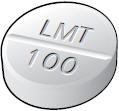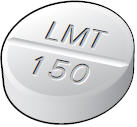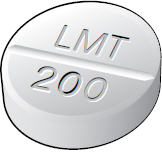MEDICATION GUIDE
Lamotrigine Tablets, USP
(la moe' tri jeen)
Read this Medication Guide before you start taking lamotrigine and each time you get a refill. There may be new information. This information does not take the place of talking with your healthcare provider about your medical condition or treatment. If you have questions about lamotrigine, ask your healthcare provider or pharmacist.
What is the most important information I should know about Lamotrigine?
- 1.
-
Lamotrigine may cause a serious skin rash that may cause you to be hospitalized or to stop lamotrigine; it may rarely cause death.
There is no way to tell if a mild rash will develop into a more serious reaction. These serious skin reactions are more likely to happen when you begin taking lamotrigine, within the first 2 to 8 weeks of treatment. But it can happen in people who have taken lamotrigine for any period of time. Children between 2 to 16 years of age have a higher chance of getting this serious skin reaction while taking lamotrigine.
The risk of getting a rash is higher if you:- take lamotrigine while taking valproate [DEPAKENE (valproic acid) or DEPAKOTE (divalproex sodium)]
- take a higher starting dose of lamotrigine than your healthcare provider prescribed
- increase your dose of lamotrigine faster than prescribed.
Call your healthcare provider right away if you have any of the following:- a skin rash
- hives
- fever
- swollen lymph glands
- painful sores in your mouth or around your eyes
- swelling of your lips or tongue
- yellowing of your skin or eyes
- unusual bruising or bleeding
- severe fatigue or weakness
- severe muscle pain
- frequent infections
- 2.
-
Like other antiepileptic drugs, lamotrigine may cause suicidal thoughts or actions in a very small number of people, about 1 in 500.
Call a healthcare provider right away if you have any of these symptoms, especially if they are new, worse, or worry you:- thoughts about suicide or dying
- attempt to commit suicide
- new or worse depression
- new or worse anxiety
- feeling agitated or restless
- panic attacks
- trouble sleeping (insomnia)
- new or worse irritability
- acting aggressive, being angry, or violent
- acting on dangerous impulses
- an extreme increase in activity and talking (mania)
- other unusual changes in behavior or mood
- Stopping lamotrigine suddenly can cause serious problems.
- Suicidal thoughts or actions can be caused by things other than medicines. If you have suicidal thoughts or actions, your healthcare provider may check for other causes.
- Pay attention to any changes, especially sudden changes, in mood, behaviors, thoughts, or feelings.
- Keep all follow-up visits with your healthcare provider as scheduled.
- Call your healthcare provider between visits as needed, especially if you are worried about symptoms.
- 3.
-
Lamotrigine may rarely cause aseptic meningitis, a serious inflammation of the protective membrane that covers the brain and spinal cord.
Call your healthcare provider right away if you have any of the following symptoms:- Headache
- Fever
- Nausea
- Vomiting
- Stiff neck
- Rash
- Unusual sensitivity to light
- Muscle pains
- Chills
- Confusion
- Drowsiness
Lamotrigine can have other serious side effects. For more information ask your healthcare provider or pharmacist. Tell your healthcare provider if you have any side effect that bothers you. Be sure to read the section below entitled "What are the possible side effects of Lamotrigine?" - 4.
-
Patients prescribed lamotrigine have sometimes been given the wrong medicine because many medicines have names similar to lamotrigine, so always check that you receive lamotrigine.
Taking the wrong medication can cause serious health problems. When your healthcare provider gives you a prescription for lamotrigine:- Make sure you can read it clearly.
- Talk to your pharmacist to check that you are given the correct medicine.
- Each time you fill your prescription, check the tablets you receive against the pictures of the tablets below.
These pictures show the distinct wording, colors, and shapes of the tablets that help to identify the right strength of Lamotrigine Tablets, USP. Immediately call your pharmacist if you receive a Lamotrigine Tablet, USP that does not look like one of the tablets shown below, as you may have received the wrong medication.
 |  |  |  |
| Lamotrigine Tablets USP 25 mg: Round, white, scored tablets. One side engraved with "TARO". Other side scored and engraved with "LMT" above the score and "25" below the score. | Lamotrigine Tablets USP 100 mg: Round, light peach, scored tablets. One side engraved with "TARO". Other side scored and engraved with "LMT" above the score and "100" below the score. | Lamotrigine Tablets USP 150 mg: Round, cream, scored tablets. One side engraved with "TARO". Other side scored and engraved with "LMT" above the score and "150" below the score. | Lamotrigine Tablets USP 200 mg: Round, light blue, scored tablets. One side engraved with "TARO". Other side scored and engraved with "LMT" above the score and "200" below the score. |
What is Lamotrigine?
Lamotrigine is a prescription medicine used:
- together with other medicines to treat certain types of seizures (partial seizures, primary generalized tonic-clonic seizures, generalized seizures of Lennox-Gastaut syndrome) in people 2 years or older.
- alone when changing from other medicines used to treat partial seizures in people 16 years or older.
- for the long-term treatment of Bipolar I Disorder to lengthen the time between mood episodes in people 18 years or older who have been treated for mood episodes with other medicine.
It is not known if lamotrigine is safe or effective in children or teenagers under the age of 18 with mood disorders such as bipolar disorder or depression.
It is not known if lamotrigine is safe or effective when used alone as the first treatment of seizures in adults.
Who should not take Lamotrigine?
You should not take lamotrigine if you have had an allergic reaction to lamotrigine or to any of the inactive ingredients in lamotrigine. See the end of this leaflet for a complete list of ingredients in lamotrigine.
What should I tell my healthcare provider before taking Lamotrigine?
Before taking lamotrigine, tell your healthcare provider about all of your medical conditions, including if you:
- have had a rash or allergic reaction to another antiseizure medicine.
- have or have had depression, mood problems or suicidal thoughts or behavior.
- are taking oral contraceptives (birth control pills) or other female hormonal medicines. Do not start or stop taking birth control pills or other female hormonal medicine until you have talked with your healthcare provider. Tell your healthcare provider if you have any changes in your menstrual pattern such as breakthrough bleeding. Stopping or starting these medicines may cause side effects (such as dizziness, lack of coordination, or double vision). Starting these medicines may lessen how well lamotrigine works.
- are pregnant or plan to become pregnant. It is not known if lamotrigine will harm your unborn baby. If you become pregnant while taking lamotrigine, talk to your healthcare provider about registering with the North American Antiepileptic Drug Pregnancy Registry. You can enroll in this registry by calling 1-888-233-2334. The purpose of this registry is to collect information about the safety of antiepileptic drugs during pregnancy.
- are breastfeeding. Lamotrigine passes into breast milk and may cause side effects in a breastfed baby. If you breastfeed while taking lamotrigine, watch your baby closely for trouble breathing, episodes of temporarily stopping breathing, sleepiness, or poor sucking. Call your baby's healthcare provider right away if you see any of these problems. Talk to your healthcare provider about the best way to feed your baby if you take lamotrigine.
Tell your healthcare provider about all the medicines you take or if you are planning to take a new medicine, including prescription and non-prescription medicines, vitamins, and herbal supplements. Using lamotrigine with certain other medicines can affect each other, causing side effects.
How should I take Lamotrigine?
- Take lamotrigine exactly as prescribed.
- Your healthcare provider may change your dose. Do not change your dose without talking to your healthcare provider.
- Do not stop taking lamotrigine without talking to your healthcare provider. Stopping lamotrigine suddenly may cause serious problems. For example, if you have epilepsy and you stop taking lamotrigine suddenly, you may get seizures that do not stop. Talk with your healthcare provider about how to stop lamotrigine slowly.
- If you miss a dose of lamotrigine, take it as soon as you remember. If it is almost time for your next dose, just skip the missed dose. Take the next dose at your regular time. Do not take two doses at the same time.
- You may not feel the full effect of lamotrigine for several weeks.
- If you have epilepsy, tell your healthcare provider if your seizures get worse or if you have any new types of seizures.
- Swallow lamotrigine tablets whole.
- If you have trouble swallowing lamotrigine tablets, there may be another form of lamotrigine you can take.
- If you receive lamotrigine in a blisterpack, examine the blisterpack before use. Do not use if blisters are torn, broken, or missing.
What should I avoid while taking Lamotrigine?
- Do not drive a car or operate complex, hazardous machinery until you know how lamotrigine affects you.
What are possible side effects of Lamotrigine?
- See "What is the most important information I should know about Lamotrigine?"
Common side effects of lamotrigine include:
|
|
|
|
|
|
|
|
|
|
|
|
|
|
Tell your healthcare provider about any side effect that bothers you or that does not go away.
These are not all the possible side effects of lamotrigine. For more information, ask your healthcare provider or pharmacist. Call your doctor for medical advice about side effects. You may report side effects to FDA at 1-800-FDA-1088.
How should I store Lamotrigine?
- Store at 20°-25°C (68°-77°F) [see USP Controlled Room Temperature] in a dry place.
- Keep Lamotrigine and all medicines out of the reach of children.
General information about Lamotrigine
Medicines are sometimes prescribed for purposes other than those listed in a Medication Guide. Do not use lamotrigine for a condition for which it was not prescribed. Do not give lamotrigine to other people, even if they have the same symptoms you have. It may harm them.
This Medication Guide summarizes the most important information about lamotrigine. If you would like more information, talk with your healthcare provider. You can ask your healthcare provider or pharmacist for information about lamotrigine that is written for healthcare professionals.
For more information about lamotrigine, call 1-866-923-4914.
What are the ingredients in Lamotrigine?
Lamotrigine Tablets, USP
Active ingredient: lamotrigine.
Inactive ingredients: croscarmellose sodium, crospovidone, FD&C Blue #2 Aluminum Lake (200 mg strength only), FD&C Yellow No. 6 Lake (100 mg strength only), lactose monohydrate, magnesium stearate, microcrystalline cellulose, povidone, and yellow iron oxide (150 mg strength only).
This Medication Guide has been approved by the U.S. Food and Drug Administration.
DEPAKENE and DEPAKOTE are the property of their respective owners.
Mfd. by: Taro Pharmaceutical Industries Ltd., Haifa Bay, Israel 2624761
Dist. by: Taro Pharmaceuticals U.S.A., Inc., Hawthorne, NY 10532
This Product was Repackaged By:
State of Florida DOH Central Pharmacy
104-2 Hamilton Park Drive
Tallahassee, FL 32304
USA